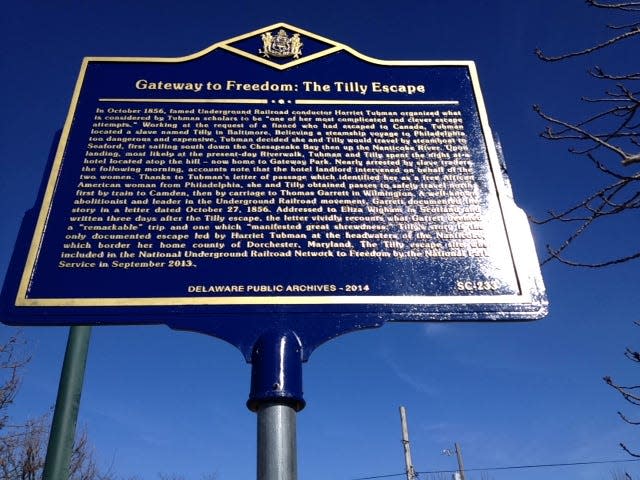Harriet Tubman's quest for liberty or death through Delaware
Araminta “Minty” Ross. was born around 1822 to enslaved parents in Dorchester County, Maryland. Minty matured into a young woman, and she earned a reputation as a hard worker.
She was around 22 years old when she met John Tubman. They fell in love and were married in 1844. When she took John’s last name, she also changed her first name, perhaps in honor of her mother, and Minty Ross became Harriet Tubman.
In October 1849, Harriet left her family, ran away from her master, and started toward Delaware. She reasoned, “There was one of two things I had a right to, liberty or death; if I could not have one, I would have the other; for no man should take me alive; I should fight for my liberty as long as my strength lasted.”
Crossing Chesapeake and Delaware Canal was formidable task
Tubman’s exact route out of Maryland has not been determined, but using the North Star as her guide, Tubman moved up the western edge of Delaware.
On cloudy nights when the stars were not visible, she followed the streams and creeks that moved generally from north to south. This kept her west of the high ground that ran down the spine of Delaware and separated the waters that flowed into the Chesapeake Bay from those that emptied into the Delaware Bay.
A formidable task that all freedom seekers traveling from southern Delaware was crossing the Chesapeake and Delaware Canal. The waterway stretched across the peninsula about a dozen miles south of Wilmington.
HISTORY: Tubman site discovery offers big clues on life of enslaved people there. What we know.
The canal’s waters were 66 feet wide and could be crossed by a swimmer of moderate ability. Those who could not swim could use a log as a rudimentary raft and paddle their way across in a matter of minutes. Close to either end of the canal were locks, whose doors could provide nimble fugitives a foot bridge over the canal, but they risked not only falling, but also discovery by the lock’s operators.
There were also several swing bridges along the canal’s route, but they were not always in place for a fugitive to cross the canal, and freedom seekers also risked discovery by the bridges’ attendants. The easiest crossing was a 247-foot covered bridge at Summit near the middle of the canal. It is not known how Tubman crossed the canal.
Walking by night and hiding by day, Tubman continued to make her way northward. Not knowing whom to trust, she used her intuition to ask strangers for food or to guide her on her way.
'I looked at my hands to see if I was the same person'

When Tubman realized that she was in a free state, she recalled, “I looked at my hands to see if I was the same person now [that] I was free. There was such a glory over everything, the sun came like gold through the trees, and over the fields, and I felt like I was in heaven.”
She also realized the bitter truth that the rest of her family, her husband, parents and siblings were still enslaved in Maryland, and unless Harriet Tubman made an effort to go back and rescue them, they would be condemned to a life of slavery.
Tubman did what few escaped slaves ever did. She returned to Maryland and Delaware (two slave states) to lead them to freedom. Harriet Tubman made over 10 trips to guide her relatives and others to freedom. If she had been captured on one these expeditions, she faced a severe flogging or worse, and a lifetime sentence of slavery.
Her most brazen exploit was leading a young woman named Tilly through Seaford in broad daylight. After slavery was abolished during the Civil War, she continued to advocate for the rights of others, but no cause was more dangerous when Harriet Tubman faced liberty or death on the Delaware Underground Railroad.

Principal sources
Larson, Kate Clifford. Bound for the Promised Land, Harriet Tubman, Portrait of an American Hero. New York: One World Random House, 2003, pp. 62-63.
Bradford, Sarah H. The Moses of Her People. New York: Geo. R. Lockwood and Son, 1897, pp. 28-32; 58-60
Gray, Ralph D. The National Waterway. Urbana: University of Illinois Press, 1967, p. 52
DELAWARE HISTORY: Delaware's history as part of the Underground Railroad to be preserved in new museum
This article originally appeared on Salisbury Daily Times: How Harriet Tubman crossed Delaware in search of liberty

